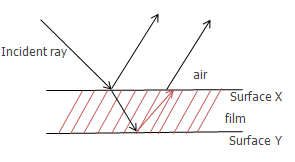Interference in thin films
Thin-film interference is a natural phenomenon in which light waves reflected by the upper and lower boundaries of a thin film interferewith one another to form a new wave. When the thickness of the film is a quarter-multiple of the wavelength of the light in the medium, the reflected waves from both surfaces interfere to "destroy" each other. Since the wave cannot be reflected, it is completely transmitted instead. A thin film is a layer of material with thickness in the sub-nanometer to micron range. As light strikes the surface of a film it is either transmitted or reflected at the upper surface. Light that is transmitted reaches the bottom surface and may once again be transmitted or reflected. The Fresnel equations provide a quantitative description of how much of the light will be transmitted or reflected at an interface.The reflection, refraction and diffraction of light waves is one strand of evidence. The interference of light waves is a second strand of evidence.

Applications
Thin films are used commercially in anti-reflection coatings, mirrors, and optical filters. They can be engineered to control the amount of light reflected or transmitted at a surface for a given wavelength. A Fabry–Pérot etalon takes advantage of thin film interference to selectively choose which wavelengths of light are allowed to transmit through the device. These films are created through deposition processes in which material is added to a substrate in a controlled manner. Methods include chemical vapor deposition and various physical vapor deposition techniques.
